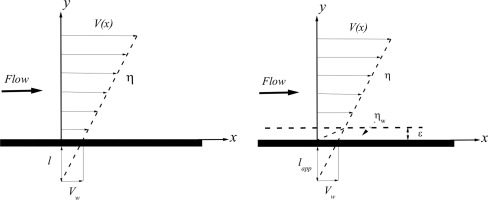Advances in Colloid and Interface Science ( IF 15.9 ) Pub Date : 2018-06-15 , DOI: 10.1016/j.cis.2018.05.008 A. Ya Malkin , S.A. Patlazhan

|
In this review, we tried to qualify different types and mechanisms of wall slip phenomenon, paying particular attention to the most recent publications and issues. The review covers all type of fluids – homogeneous low molecular weight liquids, polymer solution, multi-component dispersed media, and polymer melts. We focused on two basic concepts - fluid-solid wall interaction and shear-induced fluid-to-solid transitions - which are the dominant mechanisms of wall slip.
In the first part of the review, the theoretical and numerical studies of correlation of wetting properties and wall slip of low molecular weight liquids and polymeric fluids are reviewed along with some basic experimental results. The influence of nanobubbles and microcavities on the effectiveness of wall slip is illuminated with regard to the bubble dynamics, as well as their stability at smooth and rough interfaces, including superhydrophobic surfaces.
Flow of multi-component matter (microgel pastes, concentrated suspensions of solid particles, compressed emulsions, and colloidal systems) is accompanied by wall slip in two cases. The first one is typical of viscoplastic media which can exist in two different physical states, as solid-like below the yield point and liquid-like at the applied stresses exceeding this threshold. Slip takes place at low stresses. The second case is related to the transition from fluid to solid states at high deformation rates or large deformations caused by the strain-induced glass transition of concentrated dispersions. In the latter case, the wall effects consist of apparent slip due to the formation of a low viscous thin layer of fluid at the wall.
The liquid-to-solid transition is also a dominant mechanism in wall slip of polymer melts because liquid polymers are elastic fluids which can be in two relaxation states depending on the strain rate. The realization of these mechanisms is determined by polymer melt interaction with the solid wall.
中文翻译:

复杂液体的壁滑现象-现象及其成因
在这篇综述中,我们试图对壁滑现象的不同类型和机理进行限定,尤其要注意最新的出版物和问题。审查涵盖所有类型的流体-均质的低分子量液体,聚合物溶液,多组分分散介质和聚合物熔体。我们关注两个基本概念-流体-固体壁相互作用和剪切诱导的流体-固体过渡-这是壁滑的主要机制。
在本综述的第一部分中,对低分子量液体和聚合物液体的润湿特性与壁滑相关性的理论和数值研究进行了综述,并给出了一些基本的实验结果。就气泡动力学及其在光滑和粗糙界面(包括超疏水表面)上的稳定性而言,阐明了纳米气泡和微腔对壁滑有效性的影响。
在两种情况下,多组分物质(微凝胶糊剂,固体颗粒的浓缩悬浮液,压缩乳液和胶体系统)的流动伴随着壁滑。第一个是典型的粘塑性介质,可以以两种不同的物理状态存在,在屈服点以下呈固态,在超过此阈值的施加应力下呈液态。滑移发生在低应力下。第二种情况与由高分散率的应变诱导玻璃化转变引起的高变形率或大变形从流体状态到固态的转变有关。在后一种情况下,壁效应包括明显的滑移,这是由于在壁上形成了低粘度的薄流体层所致。
液体到固体的转变也是聚合物熔体壁滑的主要机理,因为液体聚合物是弹性流体,根据应变速率可以处于两种弛豫状态。这些机制的实现取决于聚合物与固体壁的熔融相互作用。











































 京公网安备 11010802027423号
京公网安备 11010802027423号